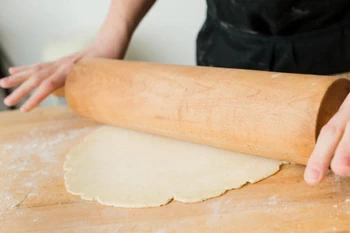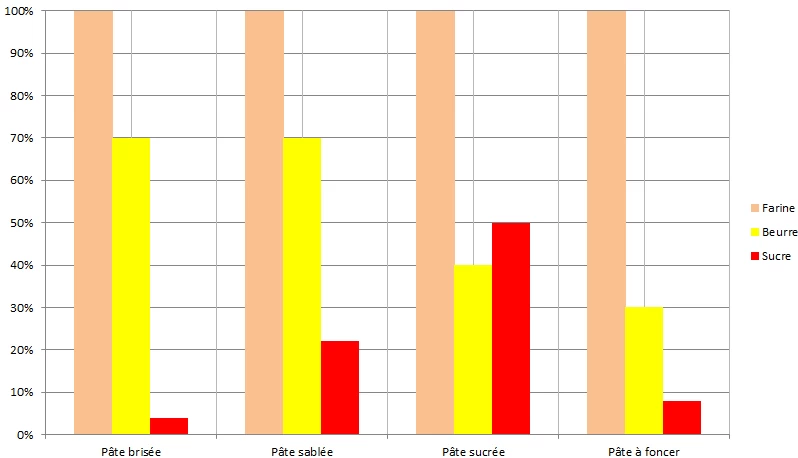This site uses only a few technical cookies necessary for its operation. By continuing to browse, you accept their use.
To find out more...
To find out more...
Pastry doughs

To make a classic tart, you'll need a pastry of course, and if you don't use puff pastry (normally reserved for "fine", in french, tarts), you'll have a choice of shortcrust, shortbread, sweetcrust or "à foncer".
Let's take a look at the differences between these four.
Let's take a look at the differences between these four.
8,649 4.4/5 (8 reviews)
Keywords for this post:PastryDoughShortbreadSweetShortcrustButterSugarFlourProportionsPercentageLast modified on: August 16th 2024
Pastry doughs
First of all, what they have in common: All four are basic French pastry doughs, known as "sèches" (dry). They are made to fill molds, mainly for tarts or tartlets, and are very similar in appearance.
The minimum ingredients, common to all, are :
Here's a table showing the values and percentages of each, for a recipe using 500g of flour:
And the same values in graph form:
Of course, all this is related to the recipes I use, and which are on this same site, but there are practically as many as there are pastry chefs (pro or amateur), which obviously makes the proportions vary, and even sometimes the ingredients: some will tell you that there's no egg, but water or milk, in shortcrust pastry for example.
But here are a few general remarks:
The minimum ingredients, common to all, are :
- Flour
- Butter
- Sugar
- Salt (a little)
Here's a table showing the values and percentages of each, for a recipe using 500g of flour:
| Shortcrust pastry (pâte brisée) | Shortbread pastry (pâte sablée) | Sweet pastry (pâte sucrée) | Pâte "A foncer" | |
|---|---|---|---|---|
| Flour | 500 gr | 500 g | 500 g | 500 g |
| Butter | 350 gr (70%) | 350 gr (70%) | 200 gr (40%) | 150 gr (30%) |
| Sugar | 20 gr (4%) | 110 gr (22%) | 250 gr (50%) | 40 gr (8%) |
And the same values in graph form:

Of course, all this is related to the recipes I use, and which are on this same site, but there are practically as many as there are pastry chefs (pro or amateur), which obviously makes the proportions vary, and even sometimes the ingredients: some will tell you that there's no egg, but water or milk, in shortcrust pastry for example.
But here are a few general remarks:
- As you'll have noticed, sweet pastry lives up to its name: it's very sweet.
- There's a little sugar in pâte brisée, even though it's used in many savoury tarts, and this is important for coloring during baking (see this post on the subject).
- Shortcrust pastry is very well accompanied by the same weight of almond powder as its weight of sugar, which makes it tastier and crunchier - it's even almost indispensable, in my humble opinion.
- It might be tempting to replace butter with vegetable fat in these recipes, but that's not a very good idea, as the taste will be much worse.
- To simplify things a little, we could say that shortcrust and "à foncer" dough are interchangeable for a recipe, and that it's the same for shortcrust and sweet pastry.
- What they all have in common: They like the cold (which is your friend) and don't like to be kneaded or worked, otherwise they become elastic, so you need to mix their ingredients as quickly as possible.
- What they all have in common: Ideally, they should be made the day before and left overnight in the fridge before use, and they freeze well raw, in the form of a large cake, not a ball.
Lasts posts
Butter vs. grease
We often read in a recipe where a pastry is put into a mould that, just before pouring, the mould should be buttered or greased. But what's the difference between these 2 terms?December 1st 20259735
Getting out of the fridge early
Very often when you're cooking, you need to take food or preparations out of the fridge, to use them in the recipe in progress. There's nothing tricky about this: you just take them out of the fridge and use them, usually immediately, in the recipe. But is this really a good method?November 24th 20251,1105
Who's making the croissants?
When you look at a bakery from the outside, you naturally think that in the bakery, the bakers make the bread, and in the laboratory, the pastry chefs make the cakes. It's very often like that, with each of these professions having quite different ways of working, but sometimes there's also one...November 23th 20251,001
Oven height
When we put a dish or cake in the oven, we naturally tend to put it on the middle shelf, and that's what we usually do. But in some cases, this position and height can be a little tricky, so let's find out why.October 8th 20252,7365
The importance of sieving
In recipes that use a fine powder (flour, powdered sugar, etc.), you'll often see the advice to sift before using it. To sift is to pass the powder in question through a sieve (a very fine strainer) before incorporating it into your recipe. It's often advice, but is it really useful?September 3rd 20257,5283
Other pages you may also like
The window-pane test in bread-making
The home bread-makers often ask themselves “Have I kneaded my dough long enough?” . A good question, as dough that is insufficiently kneaded will not rise properly or will fall flat when the top is slashed, which is very frustrating. To know when the dough is ready, one can rely on the length...June 16th 202196 K 23.9
Steam for baking bread
What does steam have to do with bread-making? This is not only a bakers' secret, it is something you might not think of at all: if you make bread and bake it like a cake, you will end up with bread, but pale and with a thick, hard crust – a long way from the golden-brown crusty loaf you had in...June 16th 2021147 K4.5
Artichoke stalks
When preparing artichokes for cooking, you may well already know that we often need to remove the first round of leaves, if they are tatty or dirty, as well as the inedible stalk. The operative word here is “remove” , rather than “cut off”.October 25th 201653 K4.3
Should a sausage be pricked before cooking?
If you are using sausages in a recipe, you may have already asked yourself the question: Should you prick it before cooking it, or not? You will certainly find as many opinions "you should prick" as "you should not". Let's try to untangle all this.September 29th 201848 K4.1
The return of the "Norman hole"
You maybe know the "trou normand", this old gastronomic custom typically French which consists in taking a (small) glass of calvados, generally between the last course and the dessert? It's something that seems a bit anachronistic nowadays, having a glass of an alcohol of more than 60° in the...December 18th 202115 K4.8
Post a comment or question
Follow this page
If you are interested in this page, you can "follow" it, by entering your email address here. You will then receive a notification immediately each time the page is modified or a new comment is added. Please note that you will need to confirm this following.
Note: We'll never share your e-mail address with anyone else.
Alternatively: you can subscribe to the mailing list of cooling-ez.com , you will receive a e-mail for each new recipe published on the site.









